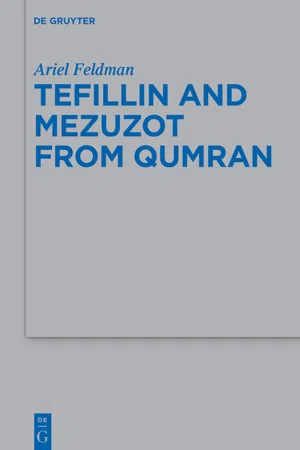
- 171 pages
- English
- ePUB (mobile friendly)
- Available on iOS & Android
About this book
This monograph studies ancient tefillin (also known as phylacteries) and mezuzot found in the Caves of Qumran. Most of these miniature texts were published by the end of 1970s and thus have long been available to scholars. And yet in several respects, these tiny fragments remain an unfinished business.
A close scrutiny of their editions reveals a presence of texts that have not been fully accounted for. These fall into three categories. First, there are multiple tefillin and mezuzot that contain legible fragments which their editors were unable to identify. Second, several tefillin and mezuzot feature imprints of letters that have not been deciphered. Third, there are texts which were provisionally classified as tefillin and mezuzot yet left unread.
This monograph offers a detailed study of these unidentified and undeciphered texts. It thus sheds new light on the contents of ancient tefillin and mezuzot and on the scribal practices involved in their preparation.
Frequently asked questions
- Essential is ideal for learners and professionals who enjoy exploring a wide range of subjects. Access the Essential Library with 800,000+ trusted titles and best-sellers across business, personal growth, and the humanities. Includes unlimited reading time and Standard Read Aloud voice.
- Complete: Perfect for advanced learners and researchers needing full, unrestricted access. Unlock 1.4M+ books across hundreds of subjects, including academic and specialized titles. The Complete Plan also includes advanced features like Premium Read Aloud and Research Assistant.
Please note we cannot support devices running on iOS 13 and Android 7 or earlier. Learn more about using the app.
Information
1 Tefillin and Mezuzot from the Judean Desert: The Artifacts
Tefillin from the Judean Desert
Table of contents
- Title Page
- Copyright
- Contents
- Abbreviations
- Frequently Cited Sources
- Introduction. Tefillin and Mezuzot from Qumran: An Unfinished Business
- 1 Tefillin and Mezuzot from the Judean Desert: The Artifacts
- 2 Tefillin and Mezuzot among Other Manuscripts of Exodus and Deuteronomy from the Judean Desert
- 3 1QPhyl (1Q13)
- 4 4QPhyl L (4Q139)
- 5 4QPhyl T (4Q147)
- 6 4QPhyl U (4Q148)
- 7 4QMez C (4Q151)
- 8 8QPhyl (8Q3)
- Conclusion
- Subject Index
- Index of Ancient Sources